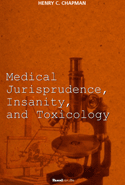|
|
|
|
||||||

|
Medical Jurisprudence, Insanity, and Toxicology
By Henry C. Chapman 1999/10 - Beard Books - Medical Classic 1893122549 - Paperback - Reprint - 327 pp. US$34.95 An intriguing early insight into medical jurisprudence and forensic medicine. Publisher Comments
This early discourse primarily on medical jurisprudence or forensic or legal medicine, makes for fascinating reading by students of law or medicine. Some of the subjects covered are: signs of death; autopsies; medico-legal definitions of wounds and blood stains; death from burns or suffocation; and rape. Separate, less detailed parts deal with insanity and toxicology. From Nightingale's Healthcare News, Review by Henry Berry: Chapman’s book, first published in 1903, fits in with the current public fascination with forensic medicine. The popularity of such television shows as “CSI” and “ER” and the many best-selling books dealing with crimes solved by the collection and testing of physical evidence attests to the attraction of “medicine in relation to law,” as Chapman puts it. Medical Jurisprudence, Insanity, and Toxicology offers an informative study on the commission of assaults and murders, their effects on victims, and their analysis to determine the cause and circumstances of death. Attorneys, medical pathologists, coroners, and expert witnesses are among those who will find this book to be especially useful. However, when Chapman first wrote this book in the late 1800s, he intended it to be read by regular medical doctors (in 1903, there were not nearly so many medical specialists as there are now), since “every physician...is liable to be called upon at any time during the course of his professional career to give testimony in cases of rape, foeticide, infanticide, death from poison, and from other causes.” A professor of medicine and medical jurisprudence, Chapman addresses violent crimes in a professional manner and covers the troubling details in a detached, scientific style that serves this subject matter well. He also discusses the subtle ways in which death can be caused and how this can test the detection abilities of forensic doctors. Part of the challenge is that murders are often committed by perpetrators who have a knowledge of poisons, anatomy, and biology that is nearly equal to that of a forensic doctor. Consequently, for many crimes the cause of death is difficult to determine and, even when it can be determined, it can be difficult to prove legally. Medical Jurisprudence, Insanity, and Toxicology is especially useful when Chapman explains how to ascertain when death occurred and how it was caused. The author shows how evidence is gathered from the body of a victim and the surrounding area (i.e., the crime scene). These dual sources of evidence are correlated and current medical knowledge applied to create a hypothesis of the cause of death. The book is thorough in its coverage –symptoms of death from suffocation, drowning, burns and scalds, heat and cold, lightning, starvation, wounds, and gun shot are among those discussed by the author. An autopsy can produce a wealth of evidence. One chapter in the book delves into the subject of wounds – the different types of wounds (incised, contused, and penetrating), what kinds of weapons inflict them, and how they cause injury and death. An analysis of blood stains also adds to the forensic doctor’s understanding of what happened. Chapman’s discussion of this subject includes methods of examining blood and the conditions influencing the coagulation of blood. The author explains that what may appear suspicious to the untrained eye may, in fact, be benign. The liver of a newborn is one example. In the case of infanticide, a key issue is whether the child was born. Thus, the first step is to determine whether birth has occurred – i.e., defined by the author as simply when a fetus has been entirely expelled from the mother’s body. Chapman proceeds to describe some of the signs, such as condition of lungs, hair, and fingernails, that would verify that an infant had been “alive” and thus could have been a victim. The size of the infant’s liver is another clue that can help answer this question. Contrary to what most persons would assume, says the author, “the liver of the fetus is larger than that of a recently born infant, and that of the infant larger than that of an eight or ten months old child.” Armed with this knowledge, the size of a child’s liver can play a role in determining if infanticide was committed and, if so, the age of the victim. However, Chapman also cautions that, “too much importance must not be attached to the size of the liver...since the difference in size...is only relative.” In another section of the book, the author explains the effect on the human body of poisons, which can act locally or remotely or both. Arsenic, for example, affects the stomach locally and the brain remotely. Chapman further explains that, to be effective, most poisons “must be absorbed – pass into the blood.” However, there are also those poisons that act as a corrosive. Thus, the blood, brain, and viscera can all be examined for the presence of a poison. Chapman identifies the physical and psychological symptoms of poisoning and directs the reader where to look in the body for evidence that poison was ingested. The advances in medicine and medical forensics have not supplanted the relevance or value of Chapman’s benchmark text. While new technology has been developed and testing procedures have become more refined, this book remains a seminal work on the application of forensic medicine in solving crimes and developing evidence for use in court.
|
|||||||||||||||||||||||||||||||||||||||||||||||||||||||||||||||
|
|
|
home
| about us
| contact us
| related
sites |